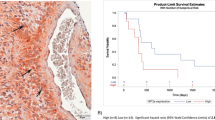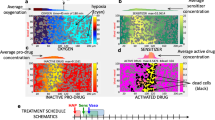Abstract
Overwhelming clinical and experimental data demonstrate that tumour hypoxia is associated with aggressive disease and poor treatment outcome as hypoxic cells are refractive to radiotherapy and some forms of chemotherapy. However, hypoxia is rare in physiologically normal tissues representing a tumour-specific condition. To selectively target this therapeutically refractive cell population, we have combined bioreductive chemotherapy with hypoxia-directed gene therapy. We have transfected the human fibrosarcoma cell line, HT1080, with a hypoxia-regulated expression vector encoding the human flavoprotein cytochrome c P450 reductase (HRE-P450R). This conferred hypoxia-dependent sensitivity to the alkylating nitroimidazole prodrug RSU1069 in vitro, with a greater than 30-fold increase in oxic/hypoxic cytotoxicity ratio compared with controls. Xenografts of both the HRE-P450R and empty vector transfectants had comparable hypoxic fractions and were refractive to single dose radiotherapy of up to 15 Gy. However, combining a prodrug of RSU1069 with a reduced radiotherapy dose of 10 Gy represents a curative regimen (50% tumour-free survival; day 100) in the HRE-P450R xenografts. In complete contrast, 100% mortality was apparent by day 44 in the empty vector control xenografts treated in the same way. Thus, an oxygen-sensitive gene-directed enzyme prodrug therapy approach may have utility when incorporated into conventional radiotherapy and/or chemotherapy protocols for loco-regional disease in any tissue where hypoxia is a contra-indication to treatment success.
This is a preview of subscription content, access via your institution
Access options
Subscribe to this journal
Receive 12 print issues and online access
$259.00 per year
only $21.58 per issue
Buy this article
- Purchase on Springer Link
- Instant access to full article PDF
Prices may be subject to local taxes which are calculated during checkout







Similar content being viewed by others
References
Gatenby RA et al. Oxygen distribution in squamous cell carcinoma metastases and its relationship to outcome of radiation therapy Int J Radiat Oncol Biol Phys 1988 14: 831–838
Okunieff P et al. Oxygen tension distributions are sufficient to explain the local response of human breast tumors treated with radiation alone Int J Radiat Oncol Biol Phys 1993 26: 631–636
Teicher BA . Hypoxia and drug resistance Cancer Metastasis Rev 1994 13: 39–68
Hockel M et al. Association between tumor hypoxia and malignant progression in advanced cancer of the uterine cervix Cancer Res 1996 56: 4509–4515
Brizel DM et al. Tumor hypoxia adversely affects the prognosis of carcinoma of the head and neck Int J Radiat Oncol Biol Phys 1997 38: 285–289
Grau C, Overgaard JE . Effect of etoposide, carmustine, vincristine, 5-fluorouracil, or methotrexate on radiobiologically oxic and hypoxic cells in a C3H mouse mammary carcinoma in situ Cancer Chemother Pharmacol 1992 300: 277–280
Graeber TG et al. Hypoxia-mediated selection of cells with diminished apoptotic potential in solid tumours Nature 1996 379: 88–91
Stratford IJ, Workman PB . Bioreductive drugs into the next millennium Anticancer Drug Des 1998 13: 519–528
Ratcliffe PJ, O'Rourke JF, Maxwell PH, Pugh CW . Oxygen sensing, hypoxia-inducible factor-1 and the regulation of mammalian gene expression J Exp Biol 1998 201: 1153–1162
Semenza GL . Hypoxia-inducible factor 1: oxygen homeostasis and disease pathophysiology Trends Mol Med 2001 7: 345–350
Maxwell PH, Pugh CW, Ratcliffe PJ . Inducible operation of the erythropoietin 3’ enhancer in multiple cell lines: evidence for a widespread oxygen-sensing mechanism Proc Natl Acad Sci USA 1993 90: 2423–2427
Zhong H et al. Overexpression of hypoxia-inducible factor 1alpha in common human cancers and their metastases Cancer Res 1999 59: 5830–5835
Dachs GU et al. Targeting gene expression to hypoxic tumour cells Nature Med 1997 3: 515–520
Koshikawa N, Takenaga K, Tagawa M, Sakiyama S . Therapeutic efficacy of the suicide gene driven by the promoter of vascular endothelial growth factor gene against hypoxic tumour cells Cancer Res 2000 60: 2936–2941
Adams GE, Ahmed I, Sheldon PW, Stratford IJ . RSU 1069, a 2-nitroimidazole containing an alkylating group: high efficiency as a radio- and chemosensitizer in vitro and in vivo Int J Radiat Oncol Biol Phys 1984 10: 1653–1656
Stratford IJ et al. RSU 1069, a nitroimidazole containing an aziridine group. Bioreduction greatly increases cytotoxicity under hypoxic conditions Biochem Pharmacol 1986 35: 105–109
Koch CJ . Unusual oxygen concentration dependence of toxicity of SR-4233, a hypoxic cell toxin Cancer Res 1993 53: 3992–3997
Patterson AV et al. Overexpression of human NADPH:cytochrome c (P450) reductase confers enhanced sensitivity to both tirapazamine (SR4233) and RSU1069 Br J Cancer 1997 76: 1338–1347
Coralli C et al. Limitations of the reporter green fluorescent protein under simulated tumour conditions Cancer Res 2001 61: 4784–4790
Ebert BL, Firth JD, Ratcliffe PJ . Hypoxia and mitochondrial inhibitors regulate expression of glucose transporter-1 via distinct Cis-acting sequences J Biol Chem 1995 270: 29083–29089
Wiesener MS et al. Constitutive activation of hypoxia-inducible genes related to overexpression of hypoxia-inducible factor-1alpha in clear cell renal carcinomas Cancer Res 2001 61: 5215–5222
Jenkins TC et al. Synthesis and evaluation of alpha-[[(2-haloethyl)amino]methyl]-2- nitro-1H-imidazole-1-ethanols as prodrugs of alpha-[(1-aziridinyl)methyl]-2- nitro-1H-imidazole-1-ethanol (RSU-1069) and its analogues which are radiosensitizers and bioreductively activated cytotoxins J Med Chem 1990 33: 2603–2610
Cowen RL et al. Viral mediated gene delivery of hypoxia regulated reductive enzymes to activate bioreductive drugs and thus improve the therapeutic index of these anti-tumour agents P295 Mol Ther 2001 3: S103
Aquino-Parsons C, Luo C, Vikse CM, Olive PL . Comparison between the comet assay and the oxygen microelectrode for measurement of tumor hypoxia Radiother Oncol 1999 51: 179–185
Rainov NG . A phase III clinical evaluation of herpes simplex virus type 1 thymidine kinase and ganciclovir gene therapy as an adjuvant to surgical resection and radiation in adults with previously untreated glioblastoma multiforme Hum Gene Ther 2000 11: 2389–2401
Raleigh JA, Chou SC, Arteel GE, Horsman MR . Comparisons among pimonidazole binding, oxygen electrode measurements, and radiation response in C3H mouse tumors Radiat Res 1999 151: 580–589
Airley R et al. Glucose transporter glut-1 expression correlates with tumor hypoxia and predicts metastasis-free survival in advanced carcinoma of the cervix Clin Cancer Res 2001 7: 928–934
Aboagye EO, Kelson AB, Tracy M, Workman P . Pre-clinical development and current status of the fluorinated 2-nitroimidazole hypoxia probe N-(2-hydroxy-3trifluoropropyl)-2-(2-nitro-1-imidazolyl) acetamide (SR 4554, CRC 94/17): a non-invasive diagnostic probe for the measurement of tumor hypoxia by magnetic resonance spectroscopy and imaging, and by positron emission tomography Anticancer Drug Des 1998 13: 703–730
van den Hoff MJ, Moorman AF, Lamers WH . Electroporation in ‘intracellular’ buffer increases cell survival Nucleic Acids Res 1992 20: 2902
Bussink J et al. Optical sensor-based oxygen tension measurements correspond with hypoxia marker binding in three human tumor xenograft lines Radiat Res 2001 154: 547–555
Acknowledgements
The collaboration with Albert van der Kogel was initiated via the Biomed II Concerted Action Programme (Development of Methods for the Rapid Analysis of Tumour Oxygenation to Allow Treatment Stratification; contract BMH4983006). Many thanks are due to Hans Peters. The Medical Research Council funded this work.
Author information
Authors and Affiliations
Rights and permissions
About this article
Cite this article
Patterson, A., Williams, K., Cowen, R. et al. Oxygen-sensitive enzyme-prodrug gene therapy for the eradication of radiation-resistant solid tumours. Gene Ther 9, 946–954 (2002). https://doi.org/10.1038/sj.gt.3301702
Received:
Accepted:
Published:
Issue Date:
DOI: https://doi.org/10.1038/sj.gt.3301702
Keywords
This article is cited by
-
Disturbance in the regulation of miR 17-92 cluster on HIF-1-α expression contributes to clinically relevant radioresistant cells: an in vitro study
Cytotechnology (2020)
-
Targeting acute hypoxic cancer cells by doxorubicin-immunoliposomes directed by monoclonal antibodies specific to RON receptor tyrosine kinase
Cancer Chemotherapy and Pharmacology (2011)
-
Adenovirus-mediated hypoxia-targeting cytosine deaminase gene therapy enhances radiotherapy in tumour xenografts
British Journal of Cancer (2007)
-
Transcriptional targeting of acute hypoxia in the tumour stroma is a novel and viable strategy for cancer gene therapy
Gene Therapy (2005)
-
Exploiting tumour hypoxia in cancer treatment
Nature Reviews Cancer (2004)



